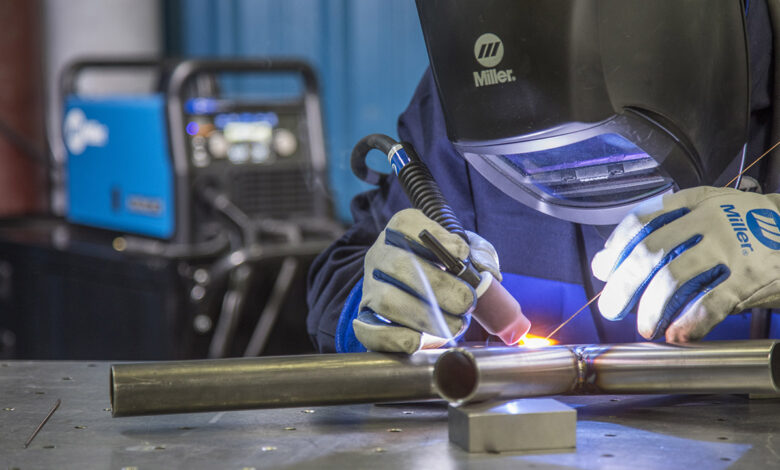What Do I Need to TIG Weld?

Knowing what you need to use to TIG weld depends on whether you are a hobbyist or have a welding shop. TIG welding is a precise technique that is compatible with many sheet metal fabrication metals, such as steel, aluminum, and stainless steel.
The first thing many TIG welders would say is that they need the right TIG welding machine. Yes, it is very important, but this article will also guide you in discussing everything you need to TIG weld, whether you are a hobbyist or want a professional welding shop.
Understanding TIG Welding
Before diving into the main part of the article, let’s quickly understand what TIG welding is and why it is common among TIG welding services. Unlike other welding methods, the advantages of TIG welding over methods like MIG welding include better control over welding and suitability for intricate work and thin materials.
Additionally, it uses a non-consumable tungsten electrode to produce the weld and shielding gas (usually argon) to protect the weld area from contamination. As a result, it is cost-effective. Using the information, you can decide whether TIG welding is the best for your project.
What You Need To TIG Weld as a DIY Enthusiast
This section is for DIY TIG welders who want to use the process at home. Below are a few things you need to TIG weld effectively and efficiently.
TIG Welding Machine
The heart of any TIG welding setup is the welding machine. A basic TIG welder with adjustable amperage settings for DIY projects will work. However, input power (120V or 240V), portability, and other factors should be considered.
Electrodes
The right electrode will determine the weld quality and degree of contamination. While TIG welding uses tungsten electrodes, they come in various types, each suitable for unique materials. For example, thoriated tungsten is better for steel and ceriated tungsten for aluminum.
Filler Rods
The filler rod function is the material added to the weld joint, and the material should match the base material. For example, the filler material ER70S-2 is better for mild steel and ER4043 for aluminum.
Protective Gear
Safety is very important in any welding process. Hence, you should invest in quality welding protective gear, which includes a helmet with an auto-darkening feature for your eyes, flame-resistant TIG welding gloves, long sleeves, and an apron.
Gas Supply
TIG welding requires an inert gas, usually argon, to shield the weld area from atmospheric contamination and produce nice TIG welds. You’ll need a gas cylinder, a regulator, and hoses to connect everything. DIY projects would most likely only need a small argon cylinder. However, you might need to check the gas supply regularly.
Workspace Setup
Last, a well-organized workspace will contribute to an efficient TIG welding operation. The workspace should have proper ventilation to prevent the buildup of harmful fumes and good lighting so you can see your work. Additionally, the workspace should be clean and free of flammable materials.
Setting Up a TIG Welding Shop
The requirement for those intending to set up a professional TIG welding shop is more extensive. Aside from the things discussed above under the DIY setup, you will need to look into the following:
Advanced TIG Welding Machines
A professional TIG welding shop would require an advanced TIG welder with features like pulse welding, which provides greater control over heat input, and AC balance control to TIG weld aluminum parts.
Automation Tools
Unlike hobbyists, you must consider purchasing automation tools for consistency and quality welding. They include foot pedals for controlling amperage or water coolers to prevent the torch from overheating during extended welding sessions.
Maintenance and Safety Protocols
You would need to develop a maintenance schedule to avoid downtime. This schedule would include checking and replacing consumables, cleaning the machine, and inspecting gas lines. Additionally, you would need to implement strict safety protocols, such as proper storage of gas cylinders.
Material Handling
Efficient material handling and storage are important, and you need to invest in storage racks for metals and consumables for better organization. Proper material handling and storage will reduce waste and improve workflow efficiency.
Which One is More Cost-Effective?
When deciding between a DIY setup and a professional shop, cost-effectiveness is a major determinant. Generally, DIY TIG welding setups are less expensive, with the cost primarily associated with the welding machine, electrodes, and protective gear. Hence, they are suitable for hobbyists or small-scale projects.
On the other hand, a professional shop setup requires a higher initial cost due to the need for advanced equipment, automation tools, and safety protocols. Hence, it is better for large-scale projects or business operations.
Investing in quality equipment is important for both setups, but based on long-term investment, a professional shop is more efficient, needs fewer repairs, and delivers better quality work. DIY hobbyists can avoid this by outsourcing to a welding service.
Conclusion
TIG welding is a precise and versatile method that requires the right tools and equipment for success. Whether you’re working on a DIY project at home or setting up a professional shop, understanding the essential components of a TIG welding setup is crucial. By investing in quality equipment and maintaining a safe, organized workspace, you can achieve high-quality welds and improve your welding skills.



